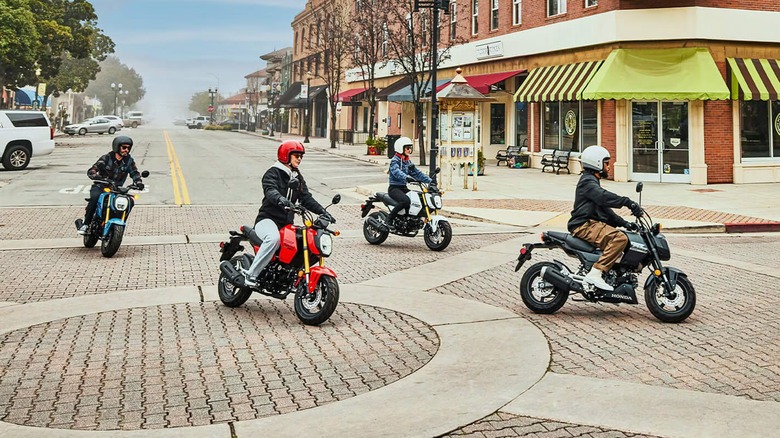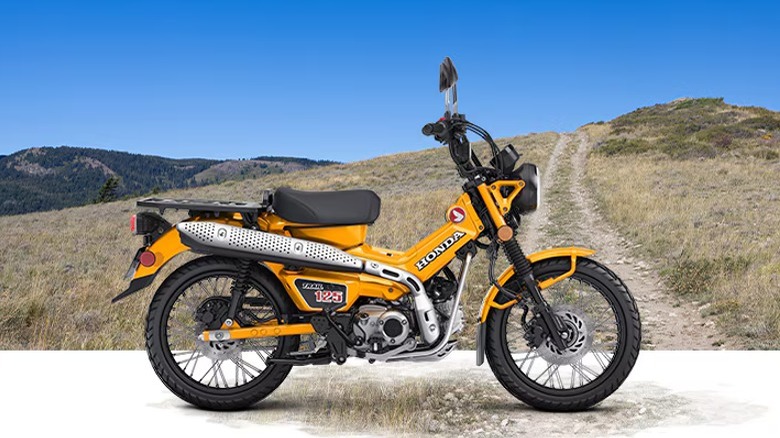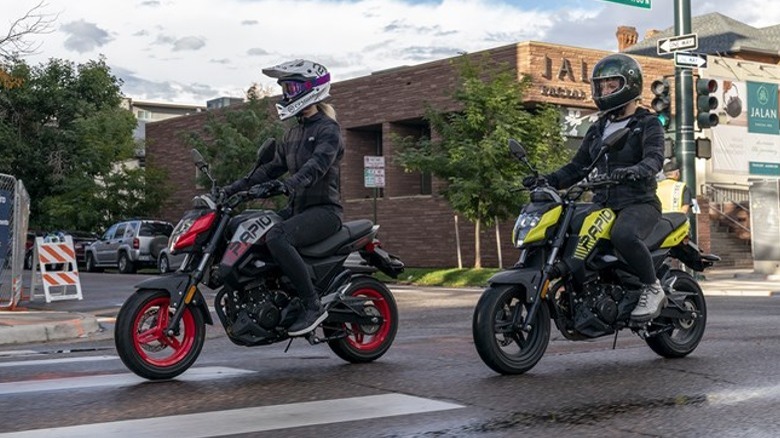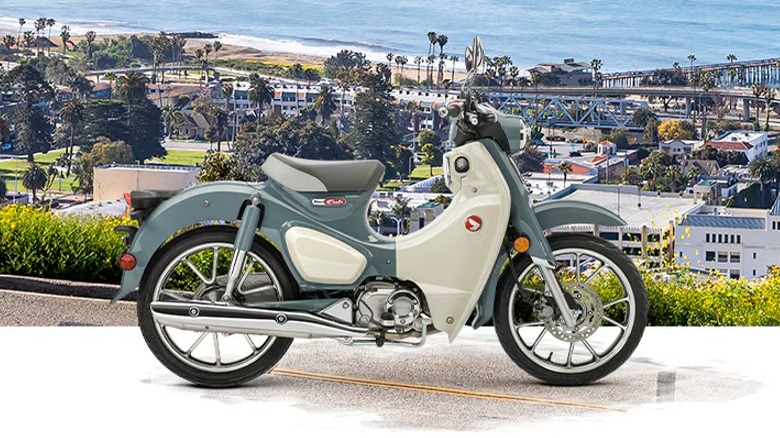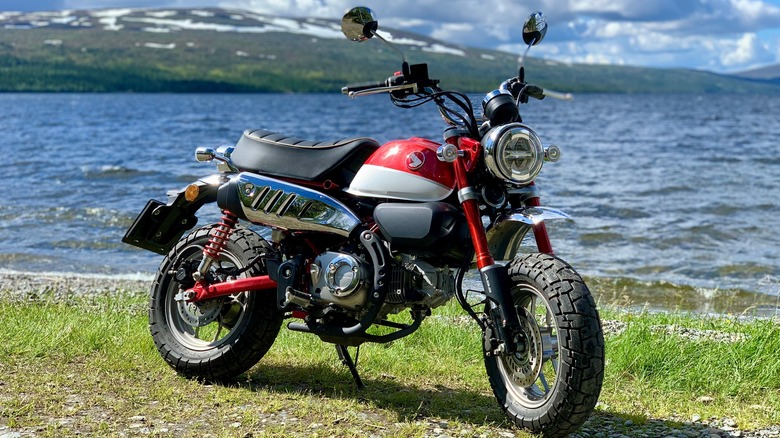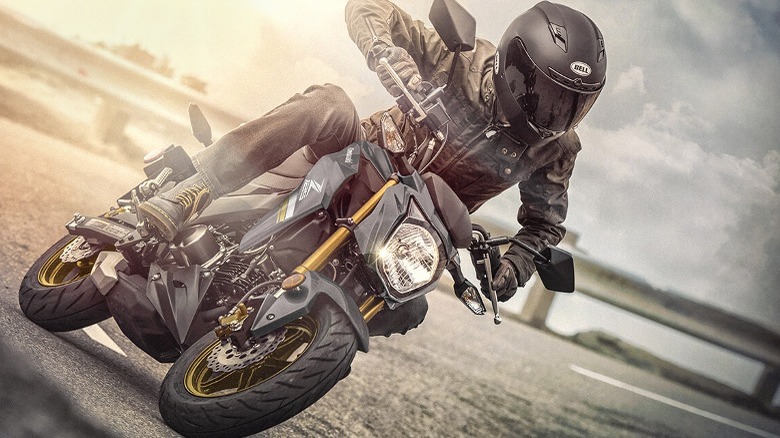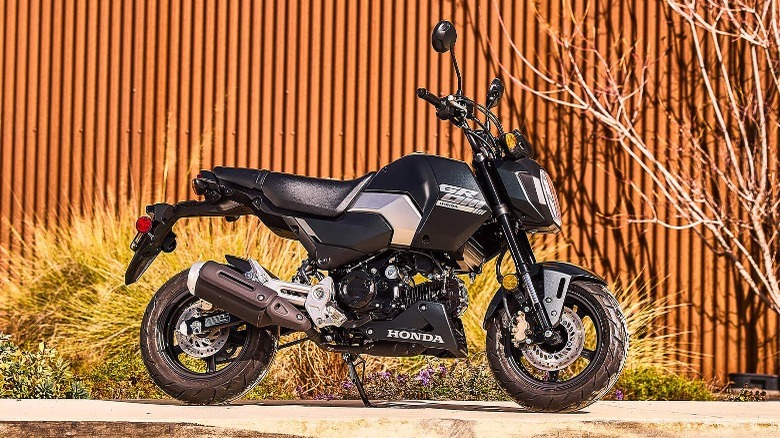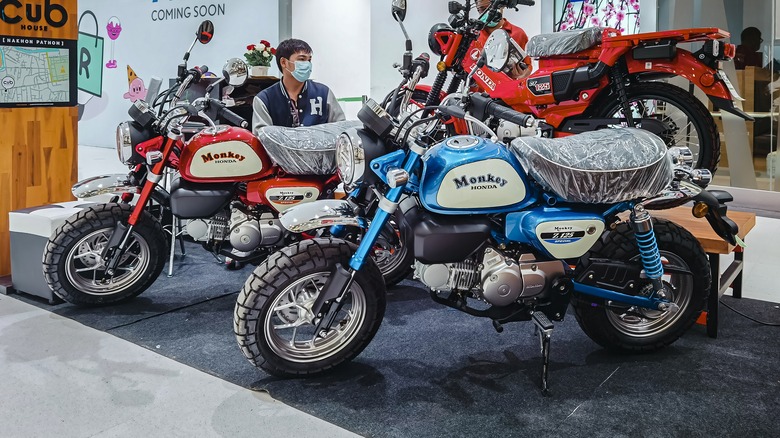6 Of The Smallest Street Legal Motorcycles You Can Get In 2024
There are a lot of motorcycle riders out there who are looking to ride the biggest and meanest bike they can get their hands on, but that isn't the case for everyone. There are several out there who enjoy smaller bikes. Miniature motorcycles have been around for decades, but these tiny rides have had a huge boom in popularity over the last few years due to their relative affordability, easy maneuverability, and the simple fun of riding around town on a teeny tiny vehicle. That said, there are limits to how small these bikes can be while still being legal to ride on the road.
Motorcycle laws vary from country to country, and in the U.S., they can even vary from state to state. You will need to be familiar with the local laws to be sure that your bike is legal to ride on the road, as well as to know where you will be allowed to ride it. In California, for instance, bikes with engines smaller than 150ccs of displacement are legally classified as "motor-driven cycles" which have different licensing requirements and may be prohibited from riding on certain freeways or expressways if there is signage posted.
Other states set a lower cutoff at 125ccs for highway riding, or may even have no specific legal restrictions on engine size at all. But to keep it simple, we're going to stick with bikes that are close to the more capable 125cc minimum classification. With that in mind, let's take a look at six of the smallest street-legal motorcycles available in 2024.
Honda Trail125
Starting off with the heaviest bike on our list, we have the Honda Trail125. This bike replicates a form factor that goes all the way back to 1961, with a bike that simultaneously emphasizes fun and basic utility over raw performance. Some might look at the Trail125 and think that it's toy-like, but its 124cc air-cooled single-cylinder four-stroke engine can hit 7.9 horsepower at 5,710 rpm and 7.4 ft-lb of torque at 4,650 rpm, making it quite plucky at lower speeds. It's the higher speeds where you might have some trouble.
"There has to be some compromises somewhere, and that's when you get out on two-lane roads with 45 to 55 mph speed limits," Cycle World stated in its review of the 2022 model. "It's here that requires either tucking into the draft of the car in front of you, or slightly holding up traffic when pushing its own wind wide open at 50 mph. We've seen speeds past 60 mph, but that's only been with the benefit of a downhill slope or a tailwind. Plan accordingly." So freeways are probably not going to be your best friend when riding one of these.
It's the largest bike in Honda's lineup of mini-motorcycles and the biggest bike on this list, but that doesn't mean that it's large by any stretch of the imagination. The Trail125 is 77.2 inches long, 42.2 inches tall, and 31.7 inches wide. It has a 31.5-inch seat height, a 49.4-inch wheelbase, and a 256 pound wet curb weight.
CFMoto 126cc Papio
Next up is the only Chinese bike on this list, the 126cc Papio is made by Zhejiang CFMoto Power Co Ltd. This miniature motorcycle is small in stature while maintaining the look and feel of a modern naked street bike. It's armed with a 126cc engine that can hit 9.4 horsepower at 8,500 rpm and 6.1 ft-lbs of torque at 8,500 rpm, giving it a bit more oomf. Like most small-engine bikes, it's most comfortable in the zero to 35 mph range, with it taking a bit more time to achieve higher speeds. Revzilla reported that the bike achieves a top speed of 55 mph, putting it right around the minimum top speed you need for basic highway travel. "Outside of just being pure fun, the Papio was incredibly easy to ride and maneuver," they said.
This bike shaves a little under a foot from just about every direction and a few pounds to boot when compared to the Trail 125. The 126cc Papio is 68-inches long, 30-inches wide, and 39-inches tall. It has a 30.5-inch seat height, a 48-inch wheelbase, and a 251 pound wet curb weight.
Honda Super Cub
The Honda Super Cub has been around since 1958 and has had riders scratching their heads ever since. Honda classifies it as a motorcycle, but many have vehemently insisted that it is more of a motorized scooter. The curvature of its body and general friendliness of its design certainly stand apart from the more intimidating, industrial-inspired frameworks that spawned from most American and European motorcycle companies of the time.
Like the Trail125, the Super Cub runs on a 124cc air-cooled single-cylinder four-stroke engine. "I saw 65 mph on flat ground and still had some room to go," Cycle World reported in their review of the 2019 model. "But this bike isn't about redlining in top gear, and backing it down to 50 mph for general cruising around was much more comfortable. That's probably adequate for many commuters, but would make us avoid Southern California highways, which generally run a lot faster than that."
The Super Cub is 75.2-inches long, 28.9-inches wide, and 39.4-inches tall, with a 30.7-inch seat height, and a 48.9-inch wheelbase. This makes it a little longer than the 126cc Papio, but it's shorter, narrower and lighter with a 238-pound wet curb weight.
Honda Monkey
Now for a truly wacky mini-motorcycle. While the Trail125 favors rugged utility and the Super Cub favors casual style, the Honda Monkey fully embraces the whimsy of riding a tiny motorcycle. The original version of this bike was called the Monkey Z100, and it was actually designed in partnership with the Motorsports Land Corporation as an amusement park ride. But in addition to being one of the smallest, it's also one of the coolest-looking 125cc motorcycles ever made. It has a compact, flat body design with upright handlebars, meaty tires, and an exposed rear suspension.
This is yet another Honda powered by a 124cc air-cooled single-cylinder four-stroke engine, though this bike certainly isn't the fastest. "The Honda Monkey has just enough momentum inside it to make you feel cool and be capable for urban assault," said Cycle News. "It's not fast. It's pretty slow, actually. But it can move away from stoplights quick enough to be carpool competitive up to about 40 mph. It's better on 25-35 mph streets and Dairy Queen parking lots."
The Monkey is truly tiny. It's 67.4-inches long, 29.6-inches wide, and 40.5-inches tall. It has a 30.5-inch seat height, a 45-inch wheelbase, and a 231-pound wet curb weight. It's bigger than a toy, but not by much.
Kawasaki Z125 Pro
Now, moving on to the only other non-Honda motorcycle on our list: the Kawasaki Z125 Pro. This motorcycle is a street fighter built to compete with the growing popularity of the Honda Grom that manages to fit a whole lot of attitude into a very small package. Like the Papio, this bike is a little more performance minded than some of its peers. It has a 125cc, four-stroke, one-cylinder, SOHC, two-valve, air-cooled engine. "At 125cc, the SOHC four-stroke bike won't be railing down the freeway, but it has plenty of power for the streets," writes Ride Apart. "It redlines without hesitation just past 9.5k RPM, and seems to just want to go more whenever it hits that point, instead of screaming at me like my poor Ninja 250R." They also noted that it had few issues with battling inclines and was comfortable accelerating at low to mid-speeds.
This bike is 66.9-inches long, 29.5-inches wide, and 39.6-inches tall. It has a 31.7-inch seat height, a 46.3-inch wheelbase, and a 224.8-pound wet curb weight. That's a very small, very light motorcycle. In fact, it dimensions are nearly identical to the last bike on our list — the Honda Grom — from which the Z125 almost certainly took its inspiration.
Honda Grom
Anyone interested in mini-motorcycles is bound to come across the Honda Grom at one point or another. The line was launched back in 2014 and several riders have pointed to the Grom as a primary catalyst for the rise in the popularity of miniature motorcycles over the last decade. The Grom is a straight-forward mini-street fighter, like the Z125. It also runs on a 124cc, SOHC, air-cooled single-cylinder four-stroke engine, like all of Honda's other mini bikes.
But people love the Grom because it's one of the more affordable mini motorcycles currently on the market, it's one of the most fuel efficient motorcycles on the market, and, well, it just works. "There's just something about this small bike that fires up the riding imagination," wrote Cycle World in their 2014 model review stating that they avoided highways during testing due to state requirements while also claiming that, "common sense calls for more top velocity than the 52-mph indicated speed I achieved on a level road. In town, the Grom is in its element, accelerating off the line with ease and zinging out enough power (throttle pinned) to hang with urban traffic."
The Grom is the lightest bike on our list by a very narrow margin, though its dimensions are actually ever-so-slightly larger than the Z125. It's 69.2-inches long, 28.6-inches wide, and 40-inches tall. It has a 30-inch seat height, a 47.2-inch wheelbase, and a 224-pound wet curb weight, making the standard model lighter than the Z125 Pro by just a fraction of a pound while the ABS model is a bit heavier at 227 pounds.
Our methodology
In order to write this article, I drew on my 15 years of motorcycle riding experience to set terms as clearly as possible and choose bikes that best met those terms. "Street legal" can be a somewhat ambiguous descriptor since laws are different from country to country and can even change from state to state in the U.S. — particularly when it comes to highway riding. I chose the 125cc engine displacement as a good general threshold, since many bikes in this size are capable road machines that can handle just about anything short of highway conditions and are perfectly legal to ride in most areas.
Then I searched for the smallest bikes in this engine category, comparing their dimensions and weight to find the smallest and lightest machines currently available from major manufacturers. Once the list was made, I looked up independent reviews of each of these bikes that showcased their street-riding capabilities to make sure that they weren't just legal, but could safely handle urban riding conditions.
